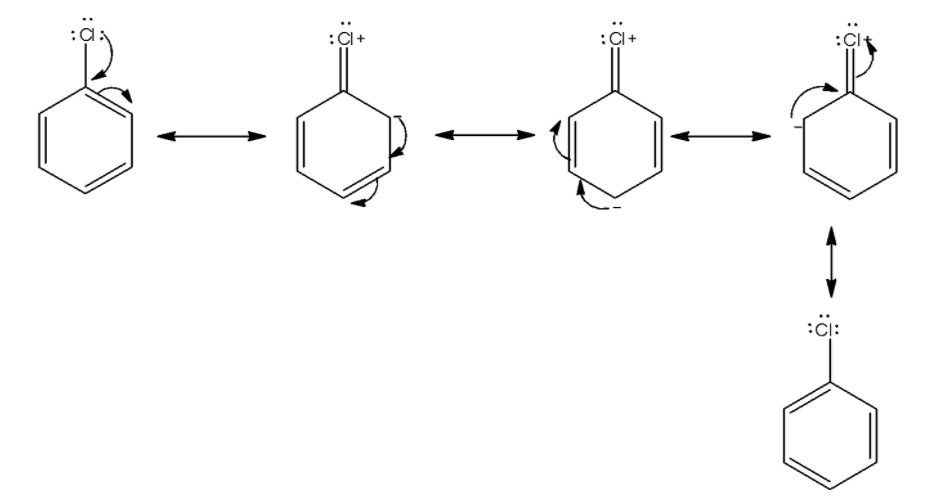
Chlorobenzene is extremely less reactive towards a nucleophilic substitution reaction. Give two reasons for the same.
Answer
137.1k+ views
Hint: We know that, in nucleophilic substitution reactions, a nucleophile attacks the positively charged atom. A nucleophile is a species, which is electron rich in nature. Some examples of nucleophiles are hydroxide ion, cyanide ion etc.
Complete step by step answer:
Resonance is the phenomenon in which delocalization of electrons occurs that causes stabilization of molecules.
We first draw the resonance in chlorobenzene. The lone pair of chlorine atoms delocalized in the benzene ring.

From the above structure we see a lone pair of electrons delocalized in the benzene ring and four resonating structures present. This causes stabilization of the molecule. So, activation energy for displacement of halogen from benzene is very much higher than displacement of alkyl halide.
In chlorobenzene, the halogen atom is bonded to the highly electronegative $sp^2$ hybridised carbon atom. So, nucleophilic substitution reaction is not possible.
Hence, two reasons for less reactivity of chlorobenzene towards nucleophilic substitution reactions are resonance in chlorobenzene and $sp^2$ hybridised nature of carbon atom bonded to chlorine atom.
Additional Information:
In a chemical reaction, replacement of one group by another is termed as substitution reaction. Substitution reactions are of three types, radical, electrophilic and nucleophilic substitution. Electrophile is a chemical species possessing electron deficient nature and nucleophile is a species possessing electron rich nature. Some examples of electrophiles are hydronium ion, bromine etc.
Note:
Students might get confused about nucleophilic and electrophilic substitution. In electrophilic substitution, an electrophile generally displaces hydrogen atom from a compound and in nucleophilic substitution, nucleophile attacks positively charged carbon.
Complete step by step answer:
Resonance is the phenomenon in which delocalization of electrons occurs that causes stabilization of molecules.
We first draw the resonance in chlorobenzene. The lone pair of chlorine atoms delocalized in the benzene ring.

From the above structure we see a lone pair of electrons delocalized in the benzene ring and four resonating structures present. This causes stabilization of the molecule. So, activation energy for displacement of halogen from benzene is very much higher than displacement of alkyl halide.
In chlorobenzene, the halogen atom is bonded to the highly electronegative $sp^2$ hybridised carbon atom. So, nucleophilic substitution reaction is not possible.
Hence, two reasons for less reactivity of chlorobenzene towards nucleophilic substitution reactions are resonance in chlorobenzene and $sp^2$ hybridised nature of carbon atom bonded to chlorine atom.
Additional Information:
In a chemical reaction, replacement of one group by another is termed as substitution reaction. Substitution reactions are of three types, radical, electrophilic and nucleophilic substitution. Electrophile is a chemical species possessing electron deficient nature and nucleophile is a species possessing electron rich nature. Some examples of electrophiles are hydronium ion, bromine etc.
Note:
Students might get confused about nucleophilic and electrophilic substitution. In electrophilic substitution, an electrophile generally displaces hydrogen atom from a compound and in nucleophilic substitution, nucleophile attacks positively charged carbon.
Recently Updated Pages
COM of Semicircular Ring Important Concepts and Tips for JEE

Geostationary Satellites and Geosynchronous Satellites for JEE

Current Loop as Magnetic Dipole Important Concepts for JEE

Electromagnetic Waves Chapter for JEE Main Physics

Structure of Atom: Key Models, Subatomic Particles, and Quantum Numbers

JEE Main 2023 January 25 Shift 1 Question Paper with Answer Key

Trending doubts
Difference Between Alcohol and Phenol

Learn About Angle Of Deviation In Prism: JEE Main Physics 2025

Types of Solutions

Physics Average Value and RMS Value JEE Main 2025

Collision - Important Concepts and Tips for JEE

Elastic Collisions in One Dimension - JEE Important Topic

Other Pages
Carbon Tetrachloride - CCl₄

NCERT Solutions for Class 12 Chemistry Chapter 3 Chemical Kinetics

Free Radical Substitution Mechanism of Alkanes for JEE Main 2025

NCERT Solutions for Class 12 Chemistry Chapter 4 The D and F Block Elements

NCERT Solutions for Class 12 Chemistry In Hindi Chapter 3 Electrochemistry Hindi Medium

NCERT Solutions for Class 12 Chemistry Chapter 8 Aldehydes Ketones and Carboxylic Acids




